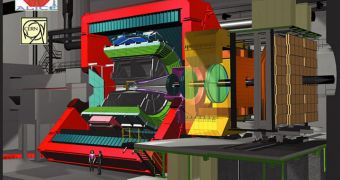The ALICE detector on the Large Hadron Collider is helping theoretical physicists understand the world of elementary particles better than ever before. The first discoveries made by the detector have been published already, less than a month after the LHC changed the material it was working with.
When the largest particle accelerator in the world was inaugurated, its 27-kilometer-long tunnels were moving proton beams through the three largest scientific experiments – ATLAS, CMS and ALICE.
Then, on November 4, a little over a month ago, the proton beam stage of the research was discontinued, and the giant machine quickly began accelerating heavy lead ions.
ALICE (A Large Ion Collider Experiment), is specialized on this type of heavy collisions. As such, less than two weeks after ion collisions had begun, experts operating it had already published a scientific paper describing new physics discovered at the facility.
The LHC ended its lead-ion tests on December 6. Just days before, the ALICE team had published two more papers on the results of the ion collisions, evidencing known phenomena in more detail.
US Department of Energy (DOE) Lawrence Berkeley National Laboratory (Berkeley Lab) physicist Peter Jacobs, the leader of the American segment of ALICE, says that the effort was both exhausting and very satisfying.
“ALICE generated four key papers in two weeks,” he explains. The detector is likely to repeat its own performance starting late November 2011, when the LHC will resume ion collisions.
Jacobs, who is based at the Berkeley Lab Nuclear Science Division (NSD), says that, once the accelerator resumes operations, in February 2011, it will start running proton beams again.
Conducting energetic collisions of heavy ions is important for reproducing and analyzing quark-gluon plasma (QGP), which is a special state of matter that permeated the Universe fractions of a second after the Big Bang took place, more than 13.7 billion years ago.
Each proton in the standard LHC beams contains three quarks and a single gluon particle, and therefore cannot replicate the QGP. On the other hand, heavy lead ions contain 82 protons and 126 neutrons, densely packed in a small space.
If you slam two lead ions head on at the tremendous energy levels only the LHC can produce, the extreme heat basically frees up the quarks and gluons, allowing the mingle and expand.
This produces a new population of particles, that can then be tracked by ALICE's sensors. Physicists hope that QGP will also be formed during this stage, as tell-tale signs that the state of matter actually exists have already been noticed.
In anticipation of next year's heavy ion collisions, experts with the ALICE collaboration will continue to browse over the collected data in hopes of discovering things they might have missed earlier on.

 14 DAY TRIAL //
14 DAY TRIAL //